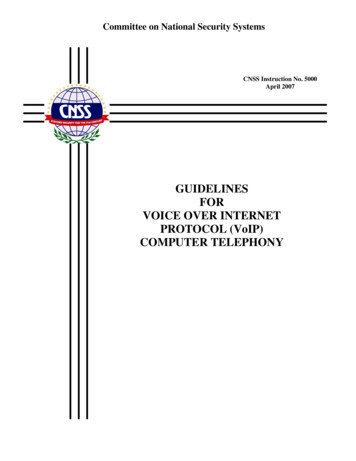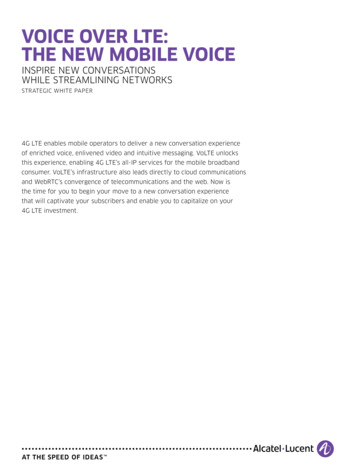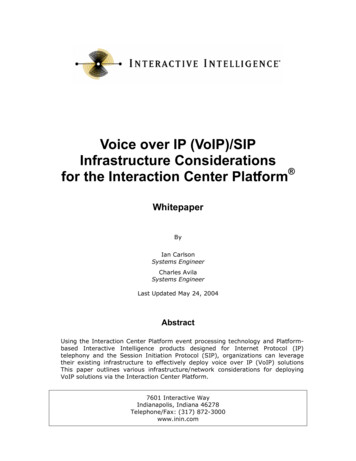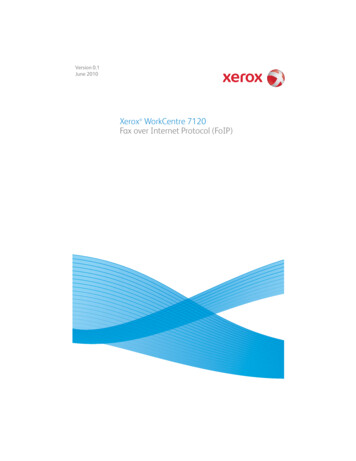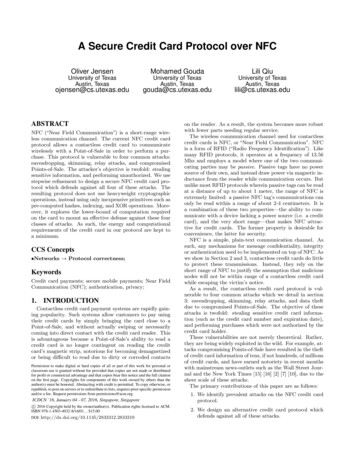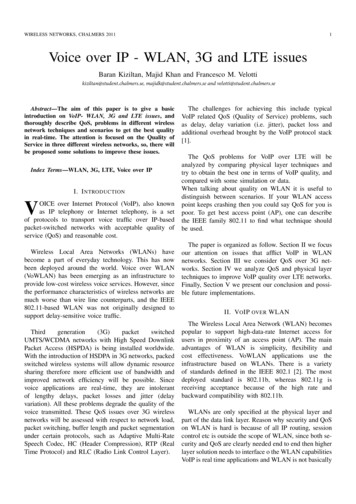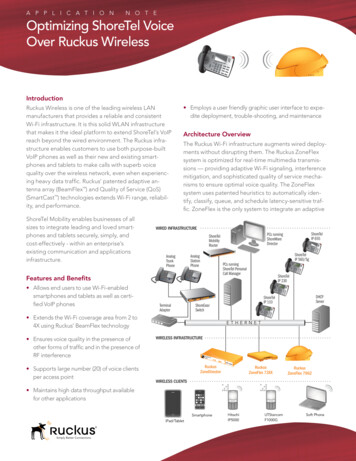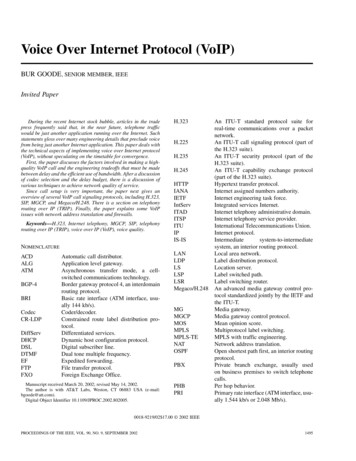
Transcription
Voice Over Internet Protocol (VoIP)BUR GOODE, SENIOR MEMBER, IEEEInvited PaperDuring the recent Internet stock bubble, articles in the tradepress frequently said that, in the near future, telephone trafficwould be just another application running over the Internet. Suchstatements gloss over many engineering details that preclude voicefrom being just another Internet application. This paper deals withthe technical aspects of implementing voice over Internet protocol(VoIP), without speculating on the timetable for convergence.First, the paper discusses the factors involved in making a highquality VoIP call and the engineering tradeoffs that must be madebetween delay and the efficient use of bandwidth. After a discussionof codec selection and the delay budget, there is a discussion ofvarious techniques to achieve network quality of service.Since call setup is very important, the paper next gives anoverview of several VoIP call signaling protocols, including H.323,SIP, MGCP, and Megaco/H.248. There is a section on telephonyrouting over IP (TRIP). Finally, the paper explains some VoIPissues with network address translation and firewalls.Keywords—H.323, Internet telephony, MGCP, SIP, telephonyrouting over IP (TRIP), voice over IP (VoIP), voice R-LDPDiffServDHCPDSLDTMFEFFTPFXOAutomatic call distributor.Application level gateway.Asynchronous transfer mode, a cellswitched communications technology.Border gateway protocol 4, an interdomainrouting protocol.Basic rate interface (ATM interface, usually 144 kb/s).Coder/decoder.Constrained route label distribution protocol.Differentiated services.Dynamic host configuration protocol.Digital subscriber line.Dual tone multiple frequency.Expedited forwarding.File transfer protocol.Foreign Exchange Office.Manuscript received March 20, 2002; revised May 14, 2002.The author is with AT&T Labs, Weston, CT 06883 USA (e-mail:bgoode@att.com).Digital Object Identifier 48MGMGCPMOSMPLSMPLS-TENATOSPFPBXPHBPRIAn ITU-T standard protocol suite forreal-time communications over a packetnetwork.An ITU-T call signaling protocol (part ofthe H.323 suite).An ITU-T security protocol (part of theH.323 suite).An ITU-T capability exchange protocol(part of the H.323 suite).Hypertext transfer protocol.Internet assigned numbers authority.Internet engineering task force.Integrated services Internet.Internet telephony administrative domain.Internet telephony service provider.International Telecommunications Union.Internet protocol.Intermediatesystem-to-intermediatesystem, an interior routing protocol.Local area network.Label distribution protocol.Location server.Label switched path.Label switching router.An advanced media gateway control protocol standardized jointly by the IETF andthe ITU-T.Media gateway.Media gateway control protocol.Mean opinion score.Multiprotocol label switching.MPLS with traffic engineering.Network address translation.Open shortest path first, an interior routingprotocol.Private branch exchange, usually usedon business premises to switch telephonecalls.Per hop behavior.Primary rate interface (ATM interface, usually 1.544 kb/s or 2.048 Mb/s).0018-9219/02 17.00 2002 IEEEPROCEEDINGS OF THE IEEE, VOL. 90, NO. 9, SEPTEMBER 20021495
Fig. 1.Business use of 7SCTPSOHOTCPTLSTDMTRIPURIURLUDPVADVoIPPublic switched telephone network.Registration, admission and status. RASchannels are used in H.323 gatekeepercommunications.Request for comment, an approved IETFdocument.ReSerVation setup protocol.RSVP with traffic engineering extensions.Real-time transport protocol.Real-time control protocol.Real-time streaming protocol.Quality of service.Session description protocol.Signaling gateway.Session initiation protocol.Signaling system 7.Stream control transmission protocol.Small office/ home office.Transmission control protocol.Transport layer security.Time-division multiplexing.Telephony routing over IP.Uniform resource identifier.Uniform resource locator.User datagram protocol.Voice activity detection.Voice over Internet protocol.I. INTRODUCTIONThere is a plethora of published papers describing various ways in which voice and data communications networks1496may “converge” into a single global communications network. This paper deals with the technical aspects of implementing VoIP, without speculating on the timetable for convergence. A large number of factors are involved in makinga high-quality VoIP call. These factors include the speechcodec, packetization, packet loss, delay, delay variation, andthe network architecture to provide QoS. Other factors involved in making a successful VoIP call include the call setupsignaling protocol, call admission control, security concerns,and the ability to traverse NAT and firewall.Although VoIP involves the transmission of digitized voicein packets, the telephone itself may be analog or digital. Thevoice may be digitized and encoded either before or concurrently with packetization. Fig. 1 shows a business in which aPBX is connected to VoIP gateway as well as to the local telephone company central office. The VoIP gateway allows telephone calls to be completed through the IP network. Localcalls can still be completed through the telephone companyas in the past. The business may use the IP network to makeall calls between its VoIP gateway connected sites or it maychoose to split the traffic between the IP network and thePSTN based on a least-cost routing algorithms configured inthe PBX. VoIP calls are not restricted to telephones served directly by the IP network. We refer to VoIP calls to telephonesserved by the PSTN as “off-net” calls. Off-net calls may berouted over the IP network to a VoIP/PSTN gateway near thedestination telephone.An alternative VoIP implementation uses IP phones anddoes not rely on a standard PBX. Fig. 2 is a simplifieddiagram of an IP telephone system connected to a wide areaIP network. IP phones are connected to a LAN. Voice callscan be made locally over the LAN. The IP phones includePROCEEDINGS OF THE IEEE, VOL. 90, NO. 9, SEPTEMBER 2002
Fig. 2.VoIP from end to end.Table 1Characteristics of Several Voice Codecscodecs that digitize and encode (as well as decode) thespeech. The IP phones also packetize and depacketize theencoded speech. Calls between different sites can be madeover the wide area IP network. Proxy servers perform IPphone registration and coordinate call signaling, especiallybetween sites. Connections to the PSTN can be madethrough VoIP gateways.II. VOICE QUALITYMany factors determine voice quality, including the choiceof codec, echo control, packet loss, delay, delay variation(jitter), and the design of the network. Packet loss causesvoice clipping and skips. Some codec algorithms can correctfor some lost voice packets. Typically, only a single packetcan be lost during a short period for the codec correction algorithms to be effective. If the end-to-end delay becomes tooGOODE: VOICE OVER INTERNET PROTOCOL (VoIP)long, the conversation begins to sound like two parties talkingon a Citizens Band radio. A buffer in the receiving devicealways compensates for jitter (delay variation). If the delayvariation exceeds the size of the jitter buffer, there will bebuffer overruns at the receiving end, with the same effect aspacket loss anywhere else in the transmission path.For many years, the PSTN operated strictly with the ITUstandard G.711. However, in a packet communications network, as well as in wireless mobile networks, other codecswill also be used. Telephones or gateways involved in settingup a call will be able to negotiate which codec to use fromamong a small working set of codecs that they support.Codecs: There are many codecs available for digitizingspeech. Table 1 gives some of the characteristics of a fewstandard codecs.11Note that the G.xxx codecs are defined by the ITU. IS-xxx codecs aredefined by the TIA.1497
Fig. 3. Effect of codec concatenation on an MOS.The quality of a voice call through a codec is oftenmeasured by subjective testing under controlled conditionsusing a large number of listeners to determine an MOS.Several characteristics can be measured by varying the testconditions. Important characteristics include the effect ofenvironmental noise, the effect of channel degradation (suchas packet loss), and the effect of tandem encoding/decodingwhen interworking with other wireless and terrestrialtransport networks. The latter characteristic is especiallyimportant since VoIP networks will have to interwork withswitched circuit networks and wireless networks usingdifferent codecs for many years. The general order of thefixed-rate codecs listed in the table, from best to worstperformance in tandem, is G.711, G.726, G.729e, G.728,G.729, G.723.1. Quantitative results are given in [1]. Sincevoice quality suffers when placing low-bit-rate codecs intandem in the transmission path, the network design shouldstrive to avoid tandem codecs whenever and whereverpossible.Concatenation and Transcoding: The best packetnetwork design codes the speech once near the speakerand decodes it once near the listener. Concatenation oflow-bit-rate speech codecs, as well as the transcoding ofspeech in the middle of the transmission path, degradesspeech quality. Fig. 3 shows the MOSs of several codecswith and without concatenation. (These results are from [1].An MOS of 5 is excellent, 4 is good, 3 is fair, 2 is poor,and 1 is very bad. Note that G.729 2 means that speechcoded with G.729 was decoded and then recoded with G.729before reaching the final decoder. G.729 3 means thatthree G.729 codecs were concatenated in the speech pathbetween the speaker and listener.) Fig. 4 shows the MOSs1498resulting from the interworking of different codecs, possiblyin a transcoding situation.III. TRANSPORTTypical Internet applications use TCP/IP, whereas VoIPuses RTP/UDP/IP. Although IP is a connectionless besteffort network communications protocol, TCP is a reliabletransport protocol that uses acknowledgments and retransmission to ensure packet receipt. Used together, TCP/IP is areliable connection-oriented network communications protocol suite. TCP has a rate adjustment feature that increasesthe transmission rate when the network is uncongested, butquickly reduces the transmission rate when the originatinghost does not receive positive acknowledgments fromthe destination host. TCP/IP is not suitable for real-timecommunications, such as speech transmission, becausethe acknowledgment/retransmission feature would lead toexcessive delays. UDP provides unreliable connectionlessdelivery service using IP to transport messages betweenend points in an internet. RTP, used in conjunction withUDP, provides end-to-end network transport functions forapplications transmitting real-time data, such as audio andvideo, over unicast and multicast network services.[2] RTPdoes not reserve resources and does not guarantee quality ofservice. A companion protocol RTCP does allow monitoringof a link, but most VoIP applications offer a continuousstream of RTP/UDP/IP packets without regard to packet lossor delay in reaching the receiver.Although transmission may be inexpensive on majorroutes, in some parts of the world as well as in many privatenetworks, transmission facilities are expensive enough toPROCEEDINGS OF THE IEEE, VOL. 90, NO. 9, SEPTEMBER 2002
Fig. 4.Effects of transcoding.merit an effort to use bandwidth efficiently. This effortstarts with the use of speech compression codecs. Use oflow bandwidth leads to a long packetization delay andthe most complex codecs. An engineering tradeoff mustbe made to achieve an acceptable packetization delay, anacceptable level of codec complexity, and an acceptable calltransmission capacity requirement. Another technique forincreasing bandwidth efficiency is voice activity detectionand silence suppression. Voice quality can be maintainedwhile using silence suppression if the receiving codec inserts a carefully designed comfort noise during each silenceperiod. For example, Annex B of ITU-T RecommendationG.729 defines a robust voice activity detector that measuresthe changes over time of the background noise and sends,at a low rate, enough information to the receiver to generatecomfort noise that has the perceptual characteristics of thebackground noise at the sending telephone [3].Coding and packetization result in delays greater thanusers typically experience in terrestrial switched circuitnetworks. As we have seen, standard speech codecs areavailable for output coding rates in the approximate rangeof 64 to 5 kb/s. Generally, the lower the output rate, themore complex the codec. Packet design involves a tradeoffbetween payload efficiency (payload/total packet size) andpacketization delay (the time required to fill the packet).For IPv4, the RTP/UDP/IP header is 40 bytes. A payloadof 40 bytes would mean 50% payload efficiency. At 64kb/s, it only takes 5 ms to accumulate 40 bytes, but at 8GOODE: VOICE OVER INTERNET PROTOCOL (VoIP)kb/s it takes 40 ms to accumulate 40 bytes. A packetizationdelay of 40 ms is significant, and many VoIP systems use20-ms packets despite the low payload efficiency whenusing low-bit-rate codecs. For continuous speech, the call(in kb/s) is relatedtransmission capacity requirement(in bits), the codec output rate (into the header sizekb/s) and the payload sample size (in milliseconds) asFig. 5 shows a plot ofversus and assumingb.There are several header compression algorithms thatwill improve payload efficiency [4]–[6]. The 40-byteRTP/UDP/IP header can be compressed to 2–7 bytes. A typical compressed header is four bytes, including a two-bytechecksum. In an IP network, header compression must bedone on a link-by-link basis, because the header must berestored before a router can choose an outgoing interface.Therefore, this technique is most suitable for low-speedversusandaccess links. Fig. 6 shows a plot ofassumingb.The lowest BW requirements lead to a long packetizationdelay and the most complex codecs. An engineering tradeoffmust be made to achieve an acceptable packetization delay,an acceptable codec complexity, and an acceptable call bandwidth requirement. The following sections discuss qualityand bandwidth efficiency in more detail.1499
Fig. 5. The varying bands, from top to bottom, represent the following VoIP bandwidthrequirements (40-byte headers): 120–140, 100–120, 80–100, 60–80, 40–60, 20–40, and 0–20.Fig. 6. From top to bottom, varying bands represent the following VoIP bandwidth requirements(4-byte headers): 70–80, 60–70, 50–60, 40–50, 30–40, 20–30, 10–20, 0–10.A. DelayTransmission time includes delay due to codec processingas well as propagation delay. ITU-T Recommendation G.114[8] recommends the following one-way transmission timelimits for connections with adequately controlled echo (complying with G.131 [7]): 0 to 150 ms: acceptable for most user applications; 150 to 400 ms: acceptable for international connections;400 ms: unacceptable for general network planning purposes; however, it is recognized that in some exceptional cases this limit will be exceeded.ITU-T Recommendation G.114 Annex B describes the results of subjective tests to evaluate the effects of pure delay onspeech quality. A test completed in 1989 showed the percentof users rating the call as poor or worse (POW) for overallquality started increasing above 10% only for delays greater1500than 500 ms, but POW for interruptability was above 10%for delays of 400 ms. One of the tests, completed in 1990,“was designed to obtain subjective reactions, in context ofinterruptability and quality, to echo-free telephone circuitsin which various amounts of delay were introduced. The results indicated that long delays did not greatly reduce meanopinion scores over the range of delay tested, viz. 1 to 1000ms of one-way delay However, observations during thetest and subject interviews after the test showed the subjectsexperienced some real difficulties in communicating at thelonger delays, although subjects did not always associate thedifficulty with the delay ”[8].A Japanese study in 1991 measured the effect of delayusing six different tasks involving more or less interruptionsin the dialogue. The delay detectability threshold was definedas the delay detected by 50% of a task’s subjects. As theinteractivity required by the tasks decreased, the delay detectability threshold increased from 45 to 370 ms of one-wayPROCEEDINGS OF THE IEEE, VOL. 90, NO. 9, SEPTEMBER 2002
Table 2Delay Budget for VoIP Using G.729 Codecdelay. As the one-way delay increased from 100 to 350 ms,the MOS connection quality decreased from 3.74 ( 0.52)to 3.48 ( 0.48), and the connection acceptability decreasedfrom 80% to 73% [8].Delay variation, sometimes called jitter, is also important.The receiving gateway or telephone must compensate fordelay variation with a jitter buffer, which imposes a delayon early packets and passes late packets with less delay sothat the decoded voice streams out of the receiver at a steadyrate. Any packets that arrive later than the length of the jitterbuffer are discarded. Since we want low packet loss, the jitterbuffer delay is the maximum delay variation that we expect. This jitter buffer delay must be included in the totalend-to-end delay that the listener experiences during a conversation using packet telephony.B. Delay BudgetPacketized voice has larger end-to-end delays than a TDMsystem, making the above delay objectives challenging. Asample on-net delay budget for the G.729 (8 kb/s) codec isshown in Table 2.This budget is not precise. The allocated jitter buffer delayof 60 ms is only an estimate; the actual delay could be largeror smaller.2 Since the sample budget does not include anyspecific delays for header compression and decompression,we may consider that, if those functions are employed, theassociated processing delay is lumped into the access linkdelay.This delay budget allows us to stay within the G.114 guidelines, leaving 29 ms for the one-way backbone network delay(Dnw) in a national network. This is achievable in smallcountries. Network delays in the Asia Pacific region, as wellas between North America and Asia, may be higher than 100ms. According to G.114, these delays are acceptable for international links. However, the end-to-end delays for VoIPcalls are considerably larger than for PSTN calls.2In the absence of Network QoS, the jitter buffer delay could be larger.With QoS and an adaptive jitter buffer, the delay could adapt down to a lowervalue during a long conversation.GOODE: VOICE OVER INTERNET PROTOCOL (VoIP)IV. NETWORK QOSThere are various approaches to providing QoS in IP networks. Before discussing the QoS options, one must considerwhether QoS is really necessary. Some Internet engineers assert that the way to provide good IP network performance isthrough provisioning, rather than through complicated QoSprotocols. If no link in an IP network is ever more than 30%occupied, even in peak traffic conditions, then the packetsshould flow through without any queue delays, and elaborate protocols to give priority to one class of packet are notnecessary. The design engineer should consider the capacityof the router components to forward small voice packets aswell as the bandwidth of the inter-router links in determiningthe occupancy of the network. If the occupancy is low, thenperformance should be good. Essentially, the debate is overwhether excess network capacity (including link bandwidthand routers) is less expensive than QoS implementation.The development of QoS features has continued becauseof the perception of some network engineers that real-timetraffic (as well as other applications) may sometimes require priority treatment to achieve good performance. Insome parts of the world, bandwidth is at least an order ofm
VoIP Voice over Internet protocol. I. INTRODUCTION There is a plethora of published papers describing var-ious ways in which voice and data communications networks may “converge” into a single global communications net-work. This paper deals with the technical aspects of imple-menting VoIP
